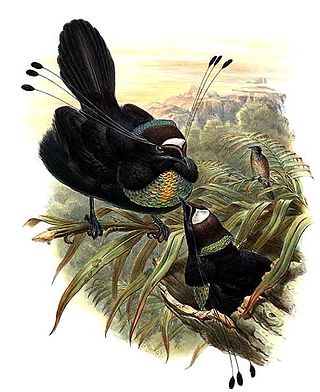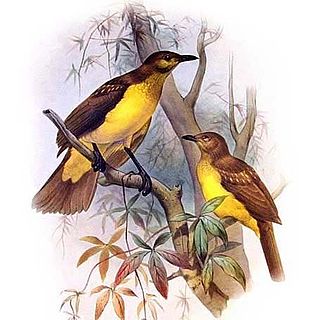
Bowerbirds make up the bird family Ptilonorhynchidae. They are renowned for their unique courtship behaviour, where males build a structure and decorate it with sticks and brightly coloured objects in an attempt to attract a mate.

The great bowerbird is a common and conspicuous resident of northern Australia, from the area around Broome across the Top End to Cape York Peninsula and as far south as Mount Isa. Favoured habitat is a broad range of forest and woodland, and the margins of vine forests, monsoon forest, and mangrove swamps.

The satin bowerbird is a bowerbird endemic to eastern Australia.

The golden-fronted bowerbird is a medium-sized, approximately 24 cm long, brown bowerbird. The male is rufous brown with an elongated golden crest extending from its golden forehead, dark grey feet and buffish yellow underparts. The female is an unadorned olive brown bird.

The green catbird is a species of bowerbird found in subtropical forests along the east coast of Australia, from southeastern Queensland to southern New South Wales. It is named after its distinctive call which sounds like a cat meowing, although it has also been mistaken for a crying child. The green catbird resembles the spotted catbird, which is found in wet tropical rainforests of Far North Queensland.

The western or Arfak parotia is a medium-sized, approximately 33 cm long, bird-of-paradise with a medium-length tail.

The golden bowerbird is a species of bird in the family Ptilonorhynchidae, the bowerbirds. It is endemic to Queensland in Australia, where it is limited to the Atherton region.

The streaked bowerbird is a species of bowerbird, native to the Bird's Tail Peninsula. They are approximately 22 cm long and have an olive-brown colouring. The male has a short orange crest which is not visible unless displayed.

The spotted catbird is a species of bowerbird (Ptilonorhynchidae) which can be found in north Queensland, the eastern Moluccas and New Guinea. Although it is a member of the bowerbird family it does not build a bower.

The regent bowerbird is a medium-sized, up to 25 cm long, sexually dimorphic bowerbird. The male bird is black with a golden orange-yellow crown, mantle and black-tipped wing feathers. It has yellow bill, black feet and yellow iris. The female is a brown bird with whitish or fawn markings, grey bill, black feet and crown. The name commemorates a prince regent of the United Kingdom.

The flame bowerbird is one of the most brilliantly coloured bowerbirds. The male is a medium-sized bird, up to 25 cm long, with flame orange and golden yellow plumage, elongated neck plumes and yellow-tipped black tail. It builds an "avenue-type" bower with two side walls of sticks. The female is an olive brown bird with yellow or golden around the stomach.

MacGregor's bowerbird is a medium-sized, up to 26 cm long, olive brown bowerbird of New Guinea's mountain forests, roughly the size and shape of an American Robin or a Eurasian Blackbird. The male is adorned with an erectile orange yellow crest, that is partly hidden until shown in courtship display. The unadorned female is similar to the male, but without the crest. Superb mimics, they are known for imitating other birds, pigs, rushing water, and even human speech.

Archbold's bowerbird is a medium-sized, dark grey songbird with brown iris, grey feet and black bill. They can grow up to 37 cm long. The male has narrow black scalloping with some trace of golden yellow crown feathers and dark grey forked tail, that shorter than the wing. Both sexes are similar. The female is smaller than male, with yellow patch on wings and has no crown feathering.

The tooth-billed bowerbird, also known as the stagemaker bowerbird or tooth-billed catbird, is a medium-sized bowerbird. It is a stocky olive-brown bird with brown-streaked buffish white underparts, grey feet, a brown iris and a distinctive serrated bill. Both sexes are similar, but the female is slightly smaller than the male. It is the only member of the genus Scenopoeetes.

The fawn-breasted bowerbird is a medium-sized, up to 32 cm (13 in) long, bowerbird with a greyish brown spotted white plumage, a black bill, dark brown iris, yellow mouth and an orange buff below. Both sexes are similar. The female is slightly smaller than the male.

The yellow-breasted bowerbird also known as Lauterbach's bowerbird, is a medium-sized, approximately 27 cm long, bowerbird with a brownish-olive upperparts plumage, grayish-yellow upper breast, coppery crown, dark brown iris, yellow underparts, a black bill and pinkish-orange mouth. Both sexes are similar. The female exhibits less vibrant coloration than the male.

The spotted bowerbird is a sedentary, mid-sized passerine found across broad parts of the drier habitats of eastern Australia. The species is known for its remarkable behaviours, like many other bowerbirds (Ptilonorynchidae), which include bower building and decorating, courtship displays and vocal mimicry. Spotted bowerbirds are locally common, however, overall the population is thought to be in decline.

The western bowerbird is a species of bird in the family Ptilonorhynchidae. The species is a common endemic of Australia. It has a disjunct distribution, occurring in Central Australia and the Pilbara region of Western Australia.

Sexual selection in birds concerns how birds have evolved a variety of mating behaviors, with the peacock tail being perhaps the most famous example of sexual selection and the Fisherian runaway. Commonly occurring sexual dimorphisms such as size and color differences are energetically costly attributes that signal competitive breeding situations. Many types of avian sexual selection have been identified; intersexual selection, also known as female choice; and intrasexual competition, where individuals of the more abundant sex compete with each other for the privilege to mate. Sexually selected traits often evolve to become more pronounced in competitive breeding situations until the trait begins to limit the individual's fitness. Conflicts between an individual fitness and signaling adaptations ensure that sexually selected ornaments such as plumage coloration and courtship behavior are "honest" traits. Signals must be costly to ensure that only good-quality individuals can present these exaggerated sexual ornaments and behaviors.

The masked bowerbird is one of the most brilliantly coloured bowerbirds. The male is a medium-sized bird, up to 25 cm long, with flame orange and golden yellow plumage, elongated neck plumes and yellow-tipped black tail. It builds an "avenue-type" bower with two side walls of sticks. The female is an olive brown bird with yellow or golden below.





















